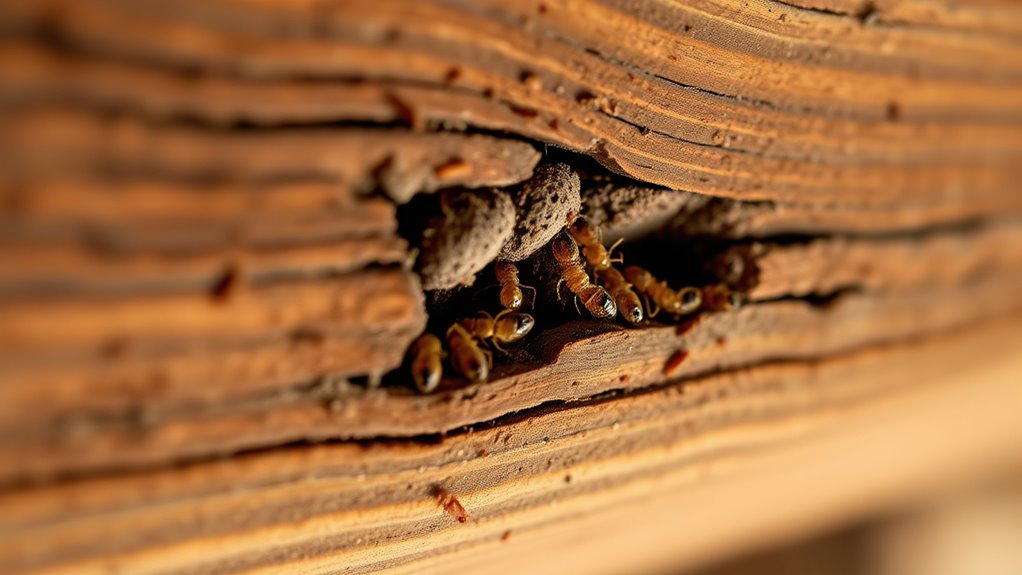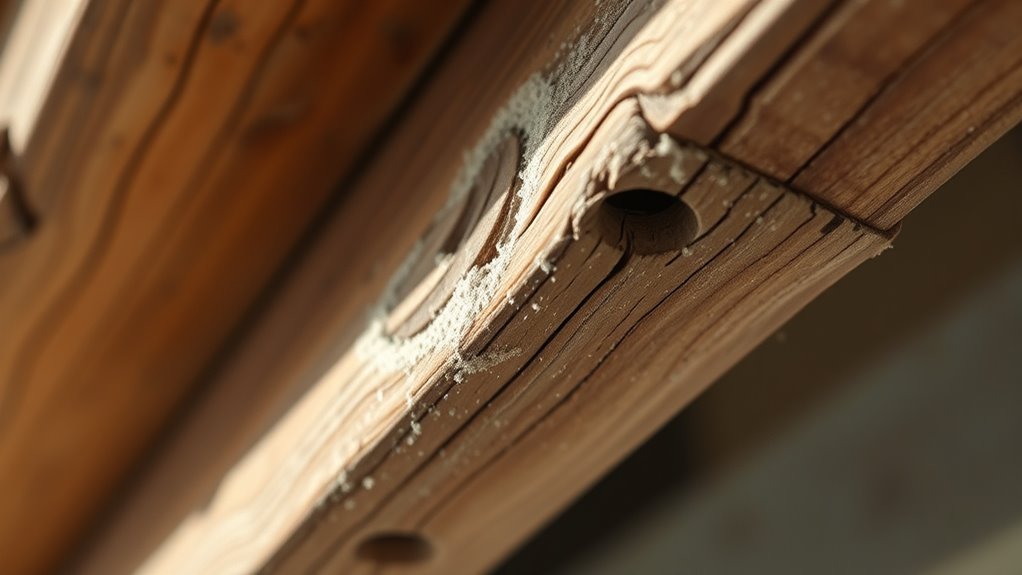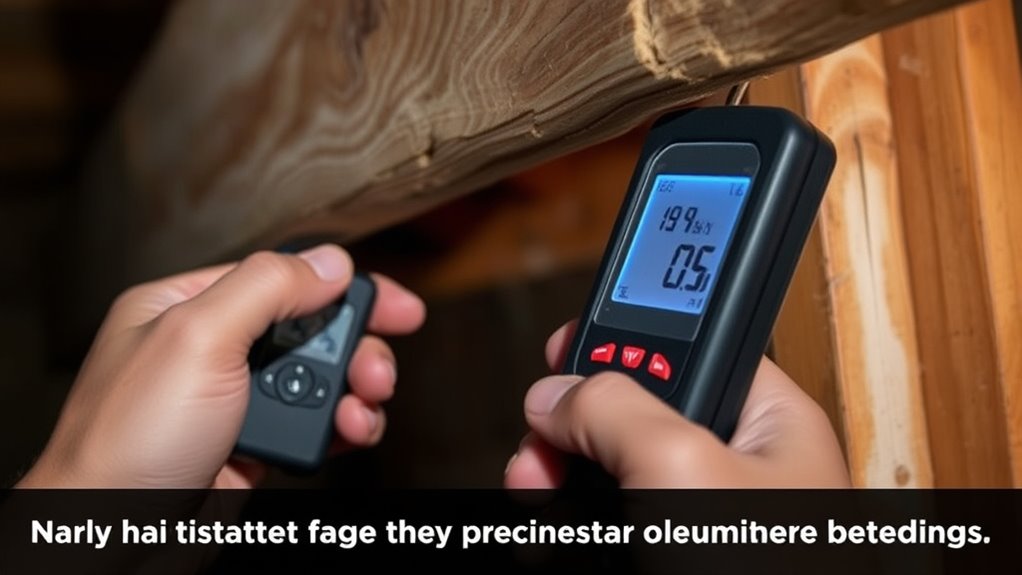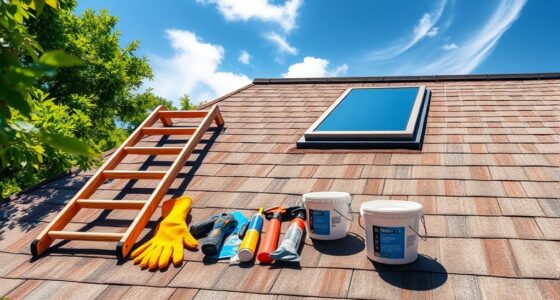To detect termite damage early, regularly inspect your home for mud tubes, tunnels, and frass near foundation walls and wood. Gently tap wooden parts to listen for hollow sounds, which indicate internal damage. Keep an eye out for wood that feels soft or looks discolored, and watch for swarm activity like discarded wings. Using moisture meters can uncover hidden issues, and professional inspections help catch problems before they cause serious harm. If you want to learn more, continue exploring how to identify signs of infestation.
Key Takeaways
- Regularly inspect for mud tubes and tunnels on foundation walls and support beams.
- Gently tap wood to identify hollow sounds indicating internal damage.
- Watch for frass (wood shavings or pellets) near baseboards or infested areas.
- Monitor for signs of swarm activity, such as winged termites or discarded wings.
- Check for structural issues like cracked foundations, bubbling paint, or soft, crumbling wood.
Recognizing Mud Tubes and Tunnels

To spot termite activity early, look for mud tubes and tunnels around your home. These mud tube constructions serve as protected pathways for termites to travel between their nest and food sources. They’re typically found on foundation walls, support beams, or in cracks and crevices. The mud tubes are about the width of a pencil and often have a rough, muddy texture. Tunnels form tunnel pathways that hide termites from predators and environmental threats while allowing them to access wood or cellulose materials inside your home. Regularly inspecting these signs can help you detect a termite problem before it causes severe damage. Remember, early detection through recognizing mud tubes and tunnel pathways is key to effective termite management. Additionally, understanding projector technology can help you better identify signs of damage in other contexts.
Inspecting Wood for Hollow Sounds

When inspecting wood for hollow sounds, start by gently tapping different areas and listening carefully. Focus on weak spots where the sound may be dull or different from solid wood, as these often indicate damage. Pay attention to sound variations, since they can signal hidden termite activity inside the wood. Incorporating regular inspections into your routine can help catch early signs of damage before it becomes severe.
Tapping Technique Tips
Tapping is a simple yet effective way to identify potential termite damage in wood. When inspecting wooden furniture or structural beams, use the palm of your hand or a small hammer to gently tap the surface. Listen carefully for a hollow sound, which may indicate internal damage. Consistent tapping across different areas helps pinpoint weak spots. If you notice a dull or drum-like noise, it could signal compromised wood. This technique also complements termite baiting strategies, allowing you to identify early signs of infestation before visible damage appears. Remember to compare sounds from various sections to distinguish between healthy and affected wood. Regular tapping inspections can catch termite activity early, saving you from costly repairs later on. Incorporating sound diagnostic techniques can further improve the accuracy of your inspections and help detect hidden infestations more effectively.
Identifying Weak Areas
By focusing on the sounds produced during inspection, you can better identify weak areas in the wood. Hollow sounds often indicate internal damage caused by termites or decay. As you tap, listen carefully for subtle differences that reveal compromised wood. Pay attention to areas with uneven moisture levels, which can weaken the wood structure. Also, check for paint peeling or bubbling, signaling moisture intrusion and potential internal damage. Weak spots may produce a duller, more muted sound compared to solid wood. These clues help you target areas needing further investigation or treatment. Remember, consistent tapping and attentive listening are key to detecting early signs of termite damage before visible signs appear. Spotting these weak areas early can save you costly repairs later. Additionally, understanding the types of headphone jacks can help you effectively use devices that might assist in inspection, such as listening devices or audio recorders.
Sound Variations Indicators
Sound variations are essential indicators of internal damage in wood, especially when inspecting for termites. You can detect hollow spots by listening for changes in sound vibrations when tapping or knocking on the wood. Healthy wood produces a solid, resonant acoustic signal, while damaged areas emit dull, muted sounds. Pay close attention to any irregularities—if a section sounds different from the surrounding material, it may indicate internal hollowing. Using a screwdriver or a rubber mallet to tap the wood helps you identify these variations more clearly. These sound vibrations serve as critical clues, guiding you to potential termite activity before visible damage appears. Recognizing these subtle acoustic signals allows for early intervention, saving you from extensive repairs later. Understanding the core personality traits] involved in attention to detail can improve your ability to notice these subtle sound differences.
Checking for Frass and Droppings

How can you tell if termites have been active in your home? Check for signs like termite frass, which looks like tiny wood shavings or granular pellets. Frass is often pushed out of tiny holes or cracks near infested wood. Look closely for these clues:
- Small piles of wood shavings or pellets under baseboards
- Frass that resembles sawdust or dirt
- Mud tubes along walls or foundations
- Tiny holes where frass is being expelled
- Damaged or hollow-sounding wood
- Recognizing these signs early can help you prevent extensive damage and address the problem promptly.
If you notice any of these signs, it indicates termite activity. Frass and wood shavings are clear indicators that termites are present and damaging your home. Early detection helps prevent extensive destruction.
Monitoring for Swarm Activity

You can catch termite swarms early by paying attention to their typical timing patterns, often occurring in warm months. Use simple visual inspection techniques around windows, lights, and foundation areas to spot winged termites. Scheduling regular seasonal checks helps guarantee you don’t miss these signs and can take action promptly. Incorporating preventive maintenance practices can further reduce the risk of undetected infestations.
Recognize Swarm Timing Patterns
Recognizing the timing of termite swarms is essential for early detection of infestations. Swarm activity typically follows predictable seasonal patterns, often occurring during warm, humid conditions. By understanding these patterns, you can better anticipate when termites are likely to mate and establish new colonies. Look for signs such as increased activity near lights or wood structures. During a mating flight, winged termites leave the colony to find mates and start new colonies. Timing is vital—most swarms happen in spring or early summer, often after rain. Being aware of these periods helps you act quickly to prevent extensive damage. Spotting these patterns early allows you to coordinate inspections or treatments before the colony becomes large and harder to control. Understanding seasonal trends can help homeowners schedule inspections more effectively.
Use Visual Inspection Techniques
Monitoring for swarm activity through visual inspection is a practical way to catch early signs of termite infestations. Look for wood staining, which often appears as irregular dark patches on walls or furniture, indicating moisture damage caused by termites. Additionally, check for paint peeling or bubbling, especially in areas with high humidity or past leaks, as termites can weaken surfaces beneath. During your inspections, pay close attention to foundation cracks, door frames, and window sills, where swarmers might emerge or leave behind discarded wings. Regularly examining these areas can help you detect signs of activity before significant damage occurs. Being vigilant and proactive with visual inspections ensures you catch termite issues early, saving you time and costly repairs down the line.
Schedule Seasonal Monitoring
Scheduling seasonal monitoring is essential because termite swarms typically occur during specific times of the year, signaling active colonies nearby. By aligning your routine with these seasonal patterns, you can catch early signs of pest activity before significant damage occurs. During peak swarm periods, you might notice:
- Swarms of winged termites emerging in windowsills or outdoor lights
- Discarded wings near entry points or on floors
- Increased mud tubes along foundation walls
- Small, scattered piles of wings in basements or crawl spaces
- Sudden movement around wooden structures during warm months
Integrating these seasonal routines into your pest management plan helps you stay vigilant and detect termite activity early, ultimately saving you time and money on repairs. Regular monitoring during these key times improves your chances of preventing severe damage.
Examining Wooden Structures and Foundations

When inspecting wooden structures and foundations for termite damage, it’s essential to look for telltale signs that might otherwise go unnoticed. Focus on areas showing wood decay, which often appears as soft, crumbly, or discolored wood. Moisture intrusion is another critical indicator, as termites thrive in damp environments; look for water stains, mold, or warped wood. Pay close attention to basement beams, sill plates, and support posts, as these are common entry points. Check for hollow-sounding wood when tapped gently, which can signal internal damage. Also, examine cracks in the foundation or uneven flooring, as they may suggest underlying structural issues caused by termite activity. Early detection through careful inspection helps prevent extensive damage and costly repairs. Additionally, understanding how automation in business is evolving can aid inspectors in utilizing advanced tools and techniques to identify hidden termite activity more effectively.
Identifying Damaged or Crumbling Wood

To identify damaged or crumbling wood, you need to pay close attention to the structure’s surface and texture. Look for areas where the wood grain appears loose or splintered. Paint peeling or bubbling can signal underlying damage and moisture problems. Cracks or soft spots are common indicators of deterioration. You might notice sections that feel spongy or crumble easily under pressure. Damaged wood often shows irregularities in its grain pattern, with fibers detaching or fraying. Keep an eye out for discolored patches or mold, which can weaken the material. These signs suggest compromised integrity, often caused by termites or rot. Additionally, timber decay can cause significant structural issues if not detected early. By recognizing these subtle clues, you can catch early damage before it worsens. Regular inspection helps maintain the safety and stability of your wooden structures.
Using Moisture Meters to Detect Hidden Infestations

Moisture meters are valuable tools for uncovering hidden termite activity that isn’t visible on the surface. By measuring moisture levels in wood and surrounding areas, you can identify spots with unusually high humidity, which often signals hidden infestations. Termites thrive in moist environments, so elevated moisture readings can point you to trouble spots before visible damage occurs. When using a moisture meter, scan wood, drywall, and other structural materials regularly, especially in areas prone to moisture buildup like basements, crawl spaces, or near plumbing leaks. Consistently high readings in these locations suggest the presence of hidden infestations that need further inspection. Detecting these moisture anomalies early allows you to address termite problems before they cause extensive damage.
Engaging Professional Inspection Services

Ever wondered if your home has hidden termite damage that you can’t see? Engaging professional inspection services is your best bet for early detection. While DIY remedies and pest control products can help manage minor issues, professionals use specialized tools like thermal imaging and acoustic sensors to identify infestations deep inside walls. They can spot signs you might miss, such as subtle mud tubes or weakened wood structures. An expert inspection provides peace of mind, ensuring you don’t rely solely on surface-level solutions. Plus, early detection by professionals can save you money and prevent extensive damage. Remember, pest control products alone aren’t enough; professional inspections are vital to uncover hidden threats before they escalate. Trust the experts to keep your home safe.
Frequently Asked Questions
How Quickly Can Termite Damage Become Structurally Dangerous?
Termite damage can become structurally dangerous surprisingly fast if not caught early. Without timely detection, the damage progression can weaken your home’s foundation in just a few months, risking collapse or costly repairs. You might not notice the signs right away, but regular inspections help identify the issue before it reaches a critical stage. Acting quickly guarantees you prevent severe damage and maintain your home’s safety and stability.
Are There Specific Signs in Non-Wooden Parts of My Home?
Think of your home as a fortress, where non-wooden parts like drywall, insulation, and pipes act as its defenses. Pest indicators such as tiny exit holes, sagging or blistered paint, and unexplained moisture or mud tubes can reveal termite activity beyond wooden structures. Keep an eye out for these non-wooden signs; they’re subtle clues that pests are undermining your home’s integrity. Early detection saves you from costly repairs later.
Can Termite Damage Be Reversed or Repaired Without Replacing Wood?
Termite damage can often be repaired without replacing wood if caught early. You can opt for wood repair techniques like filling and reinforcing damaged areas, but it’s vital to combine this with effective termite treatment to prevent further harm. Addressing the issue promptly ensures your home’s structural integrity. Always consult a professional to assess the extent of damage and determine the best approach for safe, long-lasting repairs.
What Are the Common Mistakes Homeowners Make During Inspections?
Imagine walking through your home, flashlight in hand, but missing hidden clues—this is common during inspection pitfalls. Homeowner errors often include neglecting dark corners, ignoring subtle mud tubes, or rushing through checks. These mistakes can hide signs of termite activity. To avoid them, take your time, use proper tools, and stay vigilant. Properly identifying issues early on saves you costly repairs and helps protect your home from unseen damage.
How Often Should I Schedule Professional Termite Inspections?
You should schedule professional termite inspections at least once a year to stay ahead of potential infestations. Regular inspections help identify signs of termite activity early, allowing you to implement effective pest prevention measures like wood treatment. Consistent check-ups keep your home protected, especially if you live in a high-risk area. Don’t wait until you notice damage—early detection is key to preserving your property and avoiding costly repairs.
Conclusion
Think of your home as a fortress, and termites as hidden invaders silently chipping away at its foundation. Early detection is your shield, catching these tiny threats before they breach your walls. By staying vigilant and inspecting regularly, you become the guardian of your sanctuary. Don’t let these silent destroyers turn your haven into ruins. Act now, and keep your home safe—because a strong fortress begins with early vigilance.









